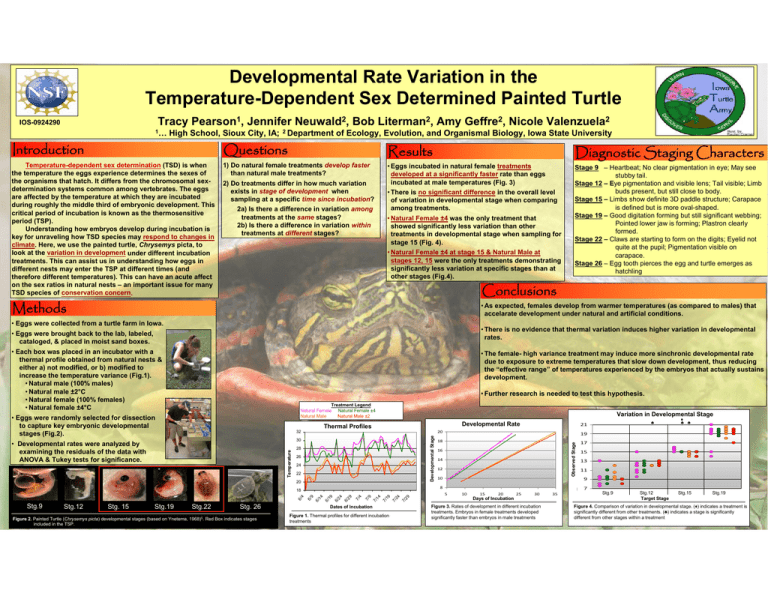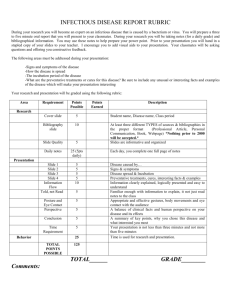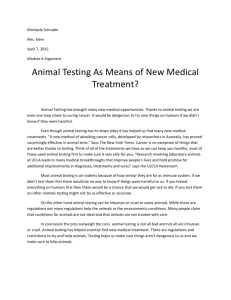Developmental Rate Variation in the Temperature-Dependent Sex Determined Painted Turtle Tracy Pearson
advertisement

Developmental Rate Variation in the Temperature-Dependent Sex Determined Painted Turtle Tracy Pearson1, Jennifer Neuwald2, Bob Literman2, Amy Geffre2, Nicole Valenzuela2 IOS-0924290 1… High School, Sioux City, IA; 2 Department of Ecology, Evolution, and Organismal Biology, Iowa State University Introduction Questions Temperature-dependent sex determination (TSD) is when the temperature the eggs experience determines the sexes of the organisms that hatch. It differs from the chromosomal sexdetermination systems common among vertebrates. The eggs are affected by the temperature at which they are incubated during roughly the middle third of embryonic development. This critical period of incubation is known as the thermosensitive period (TSP). Understanding how embryos develop during incubation is key for unraveling how TSD species may respond to changes in climate. Here, we use the painted turtle, Chrysemys picta, to look at the variation in development under different incubation treatments. This can assist us in understanding how eggs in different nests may enter the TSP at different times (and therefore different temperatures). This can have an acute affect on the sex ratios in natural nests – an important issue for many TSD species of conservation concern. 1) Do natural female treatments develop faster than natural male treatments? 2) Do treatments differ in how much variation exists in stage of development when sampling at a specific time since incubation? 2a) Is there a difference in variation among treatments at the same stages? 2b) Is there a difference in variation within treatments at different stages? Results • Eggs incubated in natural female treatments developed at a significantly faster rate than eggs incubated at male temperatures (Fig. 3) • There is no significant difference in the overall level of variation in developmental stage when comparing among treatments. • Natural Female ±4 was the only treatment that showed significantly less variation than other treatments in developmental stage when sampling for stage 15 (Fig. 4). • Natural Female ±4 at stage 15 & Natural Male at stages 12, 15 were the only treatments demonstrating significantly less variation at specific stages than at other stages (Fig.4). Diagnostic Staging Characters Stage 9 – Heartbeat; No clear pigmentation in eye; May see stubby tail. Stage 12 – Eye pigmentation and visible lens; Tail visible; Limb buds present, but still close to body. Stage 15 – Limbs show definite 3D paddle structure; Carapace is defined but is more oval-shaped. Stage 19 – Good digitation forming but still significant webbing; Pointed lower jaw is forming; Plastron clearly formed. Stage 22 – Claws are starting to form on the digits; Eyelid not quite at the pupil; Pigmentation visible on carapace. Stage 26 – Egg tooth pierces the egg and turtle emerges as hatchling Conclusions Methods • As expected, females develop from warmer temperatures (as compared to males) that accelarate development under natural and artificial conditions. • Eggs were collected from a turtle farm in Iowa. • Eggs were brought back to the lab, labeled, cataloged, & placed in moist sand boxes. • There is no evidence that thermal variation induces higher variation in developmental rates. • Each box was placed in an incubator with a thermal profile obtained from natural nests & either a) not modified, or b) modified to increase the temperature variance (Fig.1). • Natural male (100% males) • Natural male ±2°C • Natural female (100% females) • Natural female ±4°C • The female- high variance treatment may induce more sinchronic developmental rate due to exposure to extreme temperatures that slow down development, thus reducing the “effective range” of temperatures experienced by the embryos that actually sustains development. • Further research is needed to test this hypothesis. Treatment Legend Natural Female Natural Female ±4 Natural Male Natural Male ±2 Developmental Stage 32 30 Temperature • Developmental rates were analyzed by examining the residuals of the data with ANOVA & Tukey tests for significance. 28 26 24 22 20 Stg.12 Stg. 15 Stg.19 Stg.22 Stg. 26 20 19 18 17 16 14 12 10 7/ 9 7/ 14 7/ 19 7/ 24 7/ 29 9 4 4 7/ 6/ 2 19 6/ 2 6/ Dates of Incubation Figure 1. Thermal profiles for different incubation treatments ♦ ♣ ♣ 15 13 11 9 7 5 6/ 9 6/ 14 6/ 4 Stg.9 ♣ 21 8 18 Figure 2. Painted Turtle (Chrysemys picta) developmental stages (based on Ynetema, 1968)5. Red Box indicates stages included in the TSP. Variation in Developmental Stage Developmental Rate Thermal Profiles Observed Stage • Eggs were randomly selected for dissection to capture key embryonic developmental stages (Fig.2). 10 15 20 25 30 Days of Incubation Figure 3. Rates of development in different incubation treatments. Embryos in female treatments developed significantly faster than embryos in male treatments 35 Stg.9 Stg.12 Target Stage Stg.15 Stg.19 Figure 4. Comparison of variation in developmental stage. (♦) indicates a treatment is significantly different from other treatments. (♣) indicates a stage is significantly different from other stages within a treatment




